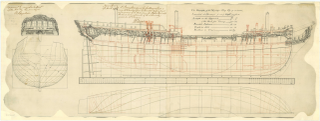 W
WHMS Atalanta was a 14 gun ship sloop of the Swan class, launched on 12 August 1775. She served during the American Revolutionary War. On 28 May 1781, Atlanta was engaged by the privateer Alliance, in which 24 crew were killed or wounded. In May 1782, under the command of Brett, she destroyed an American privateer, under then command of Ayret, near Cape d'Or. Privateers from Cumberland were on board. The privateers escaped to the woods leaving their provisions, which Captain Brett took to Cumberland.
 W
WHMS Cygnet was a 14-gun ship-sloop of the Royal Navy's Swan class, launched on 24 January 1776. She served during both the American Revolutionary War and the French Revolutionary War before being sold for disposal in 1802.
 W
WHMS Fly was a Swan class ship sloop of the Royal Navy and was launched on 14 September 1776. She performed mainly convoy escort duties during the French Revolutionary Wars, though she did capture three privateers. She foundered and was lost with all hands early in 1802.
 W
WHMS Kingfisher was the second ship in the 14-gun Swan class of ship sloops, to which design 25 vessels were built in the 1760s and 1770s. She was launched on 13 July 1770 at Chatham Dockyard, and completed there on 21 November 1770. She took part in the American Revolutionary War, enforcing the blockade of the Delaware Bay, and served in the Battle of Turtle Gut Inlet, near Cape May, New Jersey. While under the temporary command of Lieutenant Hugh Christian, she was burnt by her own crew to avoid capture on 7 August 1778 in Narragansett Bay during the Battle of Rhode Island.
 W
WHMS Pegasus was a 14-gun ship sloop of the Swan class, launched on 27 December 1776. She was commissioned the same month under Commander John Hamilton Gore and - after completing on 3 March 1777 - sailed for Newfoundland on 3 April. She was lost with all hands in a storm off Newfoundland in October.
 W
WHMS Swan was launched on 21 November 1767 at Plymouth as the lead ship of the 24 ships in the 14-gun Swan-class of ship-sloops built in the 1760s and 1770s. She served during the American Revolutionary War and the French Revolutionary War. She bore the name HMS Explosion between 1779 and 1783; at the time she was classed as a fireship. She was laid up in 1801 and finally sold in 1814. Swan then became a whaler in the Northern Whale Fishery, sailing out of Kingston-on-Hull. She also made one voyage to the Southern Whale Fishery (1819–1821) and one merchant voyage to Brazil and Hamburg, before returning to the Northern Whale Fishery. She was broken up circa. 1841.
 W
WHMS Swift was a 14-gun Swan-class ship-sloop, launched on 1 January 1777. She was commissioned that month under Lieutenant George Keppel and sailed for North America on 27 March. Command later passed to Thomas Lennox Frederick, who captained her in operations on the Delaware River. On 22 November 1778, she sank an American privateer, Rattlesnake, off Cape Henry. During the action Swift grounded and she was burnt by her crew to prevent her from falling into enemy hands.
 W
WHMS Vulture was a 14 to 16-gun ship sloop of the Swan class, launched for the Royal Navy on 18 March 1776. She served during both the American Revolutionary War and the French Revolutionary War, before the Navy sold her in 1802. Vulture is perhaps best known for being the warship to which Benedict Arnold fled on the Hudson River in 1780 after unsuccessfully trying to betray the Continental Army's fortress at West Point, New York to the British.